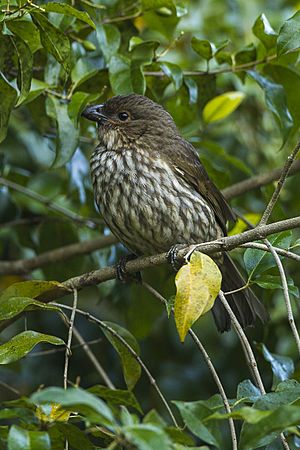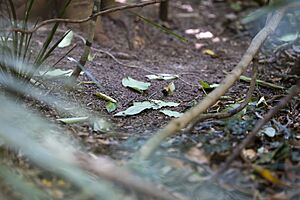Tooth-billed bowerbird facts for kids
Quick facts for kids Tooth-billed bowerbird |
|
|---|---|
 |
|
| Conservation status | |
| Scientific classification | |
| Genus: |
Scenopoeetes
|
| Species: |
dentirostris
|
The tooth-billed bowerbird (Scenopoeetes dentirostris) is a very special bird from Australia. It's also known as the stagemaker bowerbird or tooth-billed catbird. This bird is about 27 centimeters (10.6 inches) long. It has olive-brown feathers on top and streaky buff-white feathers underneath. Its feet are grey, and its eyes are brown. What makes it unique is its bill, which looks like it has teeth! Both male and female birds look similar, but the female is a little smaller. This bird is the only one of its kind in the Scenopoeetes group.
Contents
Where Does It Live?
The tooth-billed bowerbird lives only in Australia. It is found in the mountain forests of northeast Queensland. This means it is an endemic species, which means it naturally lives in only one specific area.
What Does It Eat?
This bird mainly eats fruits. It also enjoys munching on young leaves from forest trees. Its diet helps it stay healthy in its forest home.
Amazing Courtship Dance
Male tooth-billed bowerbirds are quite unique. They are polygamous, meaning one male mates with several females. To attract a female, the male builds a special area called a "display-court" or "stage-type bower."
Building the Stage
The male bird clears a space on the forest floor. He decorates this area with fresh green leaves. He carefully places the leaves with their pale underside facing up. To get the leaves, he chews through their stalks. He also makes sure to remove any old leaves from his display-court to keep it tidy.
The Performance
The display-court usually has at least one tree trunk. The male uses this trunk for perching. When a female comes near, the male drops to the ground. He then performs a special display to show off and try to impress her.
Conservation Status
The tooth-billed bowerbird is quite common in the areas where it lives. Because of this, it is listed as "least concern" on the IUCN Red List of Threatened Species. This means it is not currently in danger of disappearing.
See also
 In Spanish: Pergolero dentado para niños
In Spanish: Pergolero dentado para niños



